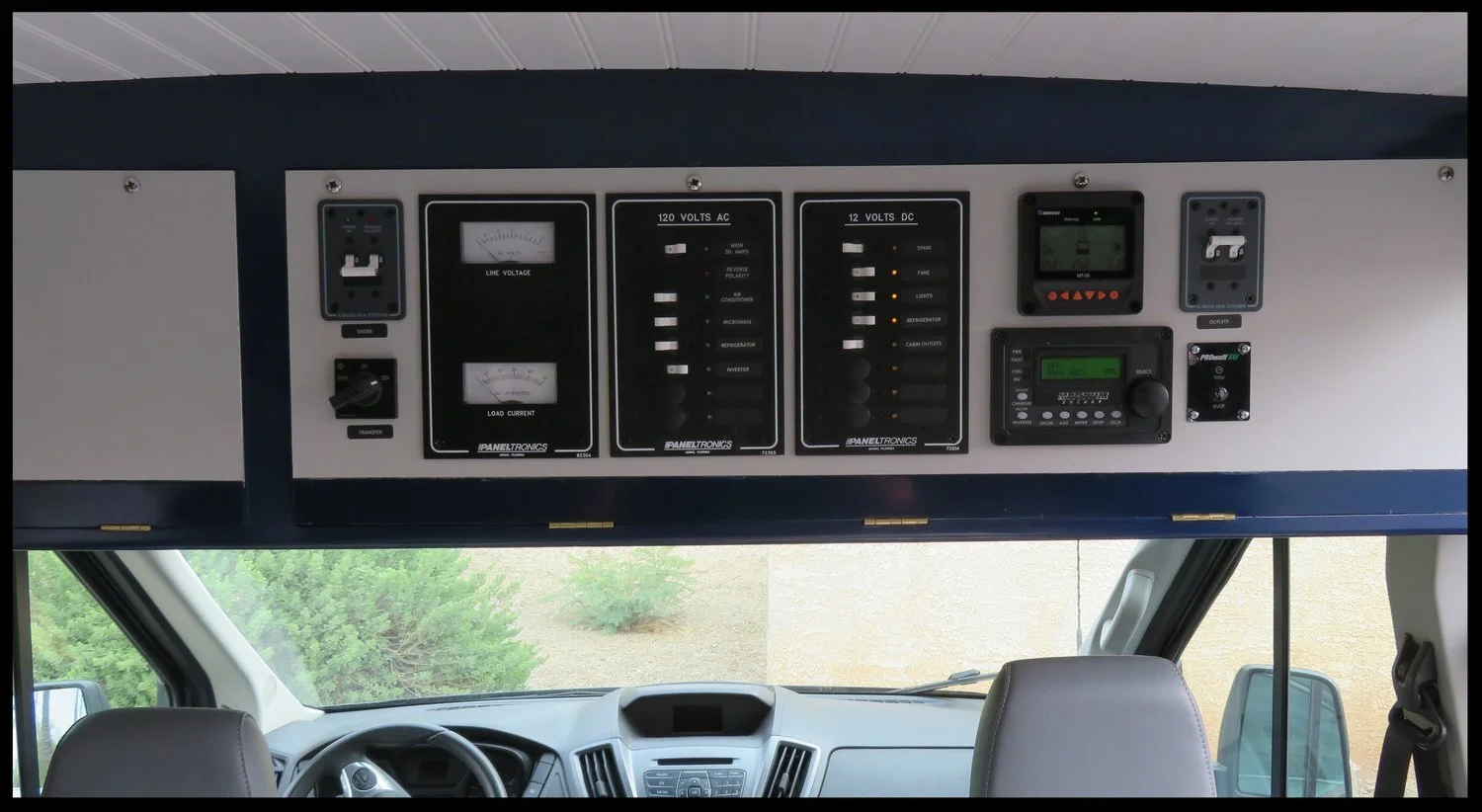Blanche's Electrical System
/When we upfitted Blue, our 2015 Ford Transit van, into a camping van, I really went overboard on the electrical system. I made provisions for any electrical appliance or gizmo we might possibly want to add in the future and built everything to the American Boat and Yacht Council (ABYC) standards. I even incorporated two marine-grade breaker panels to control and protect the AC and DC circuits, which would have made any yacht owner proud.
Not only was much of this unnecessary, overly costly, and time-consuming to build, but it also used a significant amount of prime internal cargo space.
Blue’s Electrical Control Panel was somewhat elaborate
This time around, when we upfitted Blanche, our 2019 Promaster van, I took a much simpler route. The DC circuits are, for the most part, protected by an automotive-grade fuse panel, which is tucked away in the ‘garage’ area under the bunk, and the AC circuits are protected by a simple 15-amp circuit breaker.
Here’s a quick look at the circuits:
120vac Circuits
Blanche has only two 120vac outlets. One is in the galley that is used for the coffee maker, microwave, or electric heater. The other outlet is located in the garage, under the bunk, and it is used for charging our e-bike and tool batteries. Both can be powered by either shore power, when available, or by the inverter. The shore power first passes through a 15 amp breaker, then on to the selector switch. The other input to the selector switch is the inverter. Since this is only a 15 amp circuit, the number of appliances that can be used at the same time is usually limited to one or two.
The refrigerator uses 120vac when it is available, otherwise it uses 12vdc from the house batteries. When we are connected to shore power, the 120vac goes directly to the fridge, bypassing the selector switch. When not on shore power, it is powered directly from the house batteries, which is more efficient than using the inverter power.
12vdc Circuits
The house batteries are connected to the fuse panel, which provides power to the various 12vdc circuits. The fuse panel can power up to 12 separate circuits, of which eight are currently being used. These are:
Blanche’s Fuse Panel
Battery Heater (5 amp fuse). Lithium ion batteries can’t be used if the temperature is too low or too high. In the winter months, especially when we’re traveling to the colder climes, we insulate the batteries and use a small heater to keep them warm (see the blog here).
Diesel Heater (20 amp fuse). This doesn’t get much use in Las Vegas, but when we travel north, we have a great little diesel heater to keep the interior nice and cozy. The diesel tank is mounted under the chassis, and the heater is located under the sink cabinet.
Water Pump (10 amp fuse). The water pump delivers water from a small five gallon water tank to the galley sink.
Cell Antenna (10 amp fuse). This boosts the cell reception inside our van. It includes an antenna that is attached to the outside of the vehicle which communicates with the closest cellular tower and passes the received data to an amplifier inside the van. The amplifier increases the signal strength, then creates a personal, short-range cell tower inside the vehicle. We typically see a 1-2 bar increase in signal strength. You can see more details here.
Refrigerator (10 amp fuse). When we're not on shore power (probably 99% of the time), the fridge runs on 12vdc.
Galley USB (20 amp fuse). We have several USB charging jacks aboard to keep all those digital devices charged up.
Ceiling Lights (10 amp fuse). Yup - the fuse for the ceiling lights.
Roof Fan (10 amp fuse). Blanche has a roof fan that can be used to draw cool air in from the outside or reversed and extract hot air from the interior.
Battery Charging Circuits
Blanche's house batteries can be charged either by the solar panels or by the engine alternator when the engine is running. The charging rate is controlled by a Renogy 50 amp DC to DC charger. This clever device takes the output from the solar panels, combines it with the alternator output, and converts it all to the ideal charging voltage and current for the batteries. It has a couple of limitations which I talk about in more detail here.
The outputs from both the solar panels and the alternator are fused, as is the charging circuit from the DC to DC charger to the batteries.
A sense resistor is in series with the ground return to the house batteries. It is used by the Renogy battery monitor to keep track of the battery charge level.
So Much Simpler
Not only is Blanche’s electrical system a whole lot simpler than Blue’s, we now have all that space above the front seats available for storing maps, gazeteers, camp chairs, a camp table, a vacuum, a few random hats, operators manuals for all our gear, a couple of umbrellas, and other important stuff.






